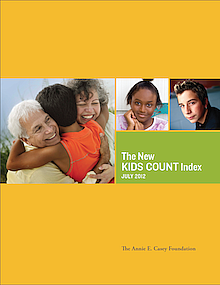KIDS COUNT reminds us of how far we've come and the challenges that remain

Twenty-five years ago, the first-ever KIDS COUNT Data Book arrived with a thump on my newsroom desk. Over the two and a half decades since, the Data Book, published by the Annie E. Casey Foundation, has helped change the way that journalists report on child health and wellbeing, helping us identify trends in child wellbeing and ground our stories in data.
Hard as it might be for many of today’s reporters to believe, in the early days the Data Book arrived via U.S. mail, with an embargo date a week or so in the future. Reporting on it was an annual ritual. This was before the internet made Big Data available to anyone with access to a computer. KIDS COUNT provided hard-to-get data on how each state’s children were faring, as well as a national context.
The recent publication of the 2014 Data Book provides an opportunity to reflect on how much progress has been made in the last 25 years to assure that children in the United States grow up in good health in stable families and communities, as well as how many challenges remain.
A major demographic trend has been the change in the overall ethnic and racial composition of the United States. As of 2012, the latest year for which official estimates are available, there were 74 million children in the United States, 12 million more than in 1990. And they were more likely to be Latino or Asian American than in 1990.
Whites represent just 53 percent of the child population today, compared with 69 percent in 1990. The proportion of Latino children has doubled to 24 percent from 12 percent, and the proportion of Asian American children has jumped to 5 percent from 3 percent, while the proportion of African American (14 percent) and Native American children (1 percent) has stayed about the same. By 2018, children of color are projected to be in the majority.
Among the positive developments for children in the last 25 years:
- Improvements in education for children of all ages. In addition, in 2012, only 15 percent of children lived in a household headed by an adult without a high school diploma, compared with 22 percent in 1990.
- A decline by more than half in the teen birth rate between 1990 and 2012.
- Gains in child health and safety, including lower child death rates and reduced usage of drugs and alcohol by teens. (The increased use of seat belts, car seats and bicycle helmets gets much of the credit for the decline in mortality.)
- Expansion of health coverage through publicly funded Medicaid and CHIP programs and the Affordable Care Act. Seven percent of children were uninsured in 2012, compared with 13 percent in 1990.
- A reduction of 45 percent in the youth incarceration rate, both because of a decline in the juvenile crime rate and juvenile justice reform.
But there was sobering news as well. The lingering effects of a lackluster economy in the early 2000s and the 2007 recession continue to mitigate some of the positive impacts of new or remodeled anti-poverty programs. Under the official poverty measurement, the child poverty rate dropped to 16 percent from 18 percent between 1990 and 2000, but grew to 22 percent today.
Some analysts believe that the official rate of measurement is faulty because it doesn’t take into account the impact of noncash government assistance, such as food stamps and housing. Using a new way to measure poverty, the Supplemental Poverty Measure, which accounts for non-cash government assistance, the child poverty rate in 2012 was 19 percent, compared with 29 percent in 1993.
Whatever the method of measurement, African American and Latino children continue to be more likely to grow up in poverty than their white counterparts. In fact, on nearly every measure of wellbeing that KIDS COUNT tracks, they are likely to fare less well than white children.
All in all, there is much progress to celebrate over the 25 years that the KIDS COUNT Data Book has tracked children’s health and wellbeing.
But there is still more work to be done. As Patrick T. McCarthy, president and CEO of the Annie E. Casey Foundation, wrote in the 2014 report: “We face the daunting challenge of creating pathways to educational and economic opportunity for all children. This will require that we confront the harsh reality that too many of our country’s children of color begin their lives with multiple disadvantages.”

